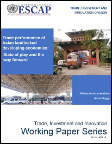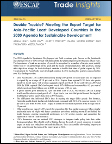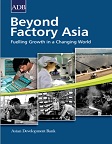South Asia Economic Focus, Fall 2018: Budget CrunchAmid a turbulent international environment, South Asia is expected to remain the fastest-growing region in the world. Growth in Bangladesh will be driven by consumption and public investment. In Bhutan, growth is expected to accelerate with the commissioning of two major hydropower projects. Growth in India firms up prompted by the adoption of the Goods and Services Tax and the recapitalization of banks. Maldives is projected to grow strongly based on dynamism in construction and tourism. Economic activity in Nepal is set to grow over the medium term while Sri Lanka’s economic growth will recover following 2017’s weather disruptions. The report highlights how growth performance is anchored on domestic consumption rather than private investment or exports. Author: World Bank Year: 2018 Download Tags: Bangladesh, Bhutan, Economic Growth, Exports East Asia Pacific Economic Update, April 2018: Enhancing PotentialEast Asia and Pacific (EAP) grew slightly faster than anticipated in 2017, with growth in Myanmar rebounding slightly at 6.4% due to strong exports. Amid risks to macroeconomic stability, EAP countries must enhance trade facilitation and integration, improve education systems, and upgrade capabilities of workers and managers. Author: World Bank Year: 2018 Download Tags: Exports, GDP, India, Manufacturing, Myanmar, Poverty Reduction, Trade Facilitation, WB Facilitating Trade between India and Sri LankaIndia and Sri Lanka have duty-free access to each other’s markets through the India-Sri Lanka Free Trade Agreement. Yet in recent years, traders from both countries have rarely utilized the agreement. This study aims to identify ways to improve importing and exporting under the agreement. It examines key issues and how to address them through the education of traders and Customs officials on goods eligible for concessions, facilitating testing and certification, streamlining Customs procedures, and establishing help desks. The study also offers recommendations in the areas of trade facilitation that may be incorporated in future negotiated agreements. Author: Suwendrani Jayaratne and Janaka Wijayasiri Year: 2016 Download Tags: Sri Lanka, India, Exports, Trade, Customs  Trade Performance of Asian Landlocked Developing Economies: State of Play and the Way ForwardMany landlocked countries remain among the world's poorest nations, despite huge political, economic and technological gains over the last two centuries. Their lack of access to coast and sea ports burden them with higher trade costs, constraining their socio-economic development prospects. This paper examines the trade performance of Asian land-locked developing countries (LLDCs), including their export performance and export diversification, and attempts to identify factors affecting their performance, such as cost of trade and trade facilitation measures, which inhibit their integration into global and regional economies. Among LLDCs in South Asia, Bhutan incurs some of the highest trade costs and Nepal faces high cost in transport services. The paper finds persistent challenges to the growth of Asian LLDCs--trade barriers and trade restrictions, lack of infrastructure and poor trade facilitation performance-- and recommends reforms that could mitigate these continuing economic challenges. Author: Witada Anukoonwattaka and Aman Saggu Year: 2016 Download Tags: Landlocked Developing Countries, Exports, Trade, UNESCAP  Double Trouble? Meeting the Export Target for Asia-Pacific Least Developed Countries in the 2030 Agenda for Sustainable Development (Trade Insights: Issue No. 15)This paper evaluates the prospects of least developed countries (LDCs) in Asia-Pacific in meeting the target set for LDCs to double their share of global exports by 2020, in Goal 17 of the Sustainable Development Goals (SDG). The paper notes that most Asia-Pacific LDCs have reported strong GDP growth turnout in recent years and are expected to grow by an average of 5.8% in 2016; difficulties faced by individual LDCs vary – Nepal, as an example, would need expansion at the average rate of 19% per year; LDCs can use national SDG strategies and go for longer-term goals—beyond the goals of export expansion—such as aiming to reach targets on trade cost reductions and trade facilitation. Author: Adam Heal, Miso Kim, Juliette Perche, Rajan Sudesh Ratna, and Pakkaporn Visetsilpanon Year: 2016 Download Tags: Least Developed Countries, Exports, Trade Facilitation, Trade, UNESCAP Aid for Trade in Asia and the Pacific 2015This Asian Development Bank report explores the potential of the digital economy to improve the inclusiveness of Aid for Trade (AfT). It uses the review of AfT as a springboard to explore new ways of thinking and how to address issues such as high trade costs in some regions. In particular, it considers how to build on information and communications technology and infrastructure connectivity from established AfT spending. The report also highlights the experience of exporters to illustrate the unique challenges and opportunities for trade-driven growth in a region where high trade costs are structural. Author: Alisa Di Caprio and Kati Suominen Year: 2015 Download Tags: ICT, Infrastructure, Trade, ADB, Asia-Pacific, Exports, Economic Growth, Trade Facilitation  Beyond Factory Asia: Fuelling Growth in a Changing WorldThis paper assesses the challenges of Factory Asia – a model of regional networks connecting production centers in different Asian economies. It forms part of regional and global value chains and constitutes an important source of growth in the region. Regional cooperation is vital to the success of Factory Asia, which calls for greater South-South cooperation to leverage knowledge in domestic manufacturing, allowing countries such as India to leapfrog to higher value chains. For Bangladesh and Sri Lanka with small domestic markets, strategic options include carving out a niche in lower-value manufacturing. The paper further argues that policymakers should be wary of expanding or increasing the number of free trade agreements for the growth or spread of production networks. Author: Asian Development Bank Year: 2013 Download Tags: South Asia, Regional Cooperation, Trade Policy, Manufacturing, Exports, Small and medium enterprises, India, Agriculture, Bangladesh Deepening Economic Cooperation between India and Sri LankaThis book analyzes the performance and impact of the India-Sri Lanka free trade agreement over the past decade and suggests the way forward. India became an important source of imports for Sri Lanka immediately after the implementation of the free trade agreement. Author: Asian Development Bank Year: 2013 Download Tags: Regional Cooperation, Trade Policy, India, Sri Lanka, Trade, Economic Cooperation, India-Sri Lanka Free Trade Agreement, Free Trade Agreements, Services, Trade Facilitation, Exports, Import Aid for Trade: An Investment Benefit Road Map for South AsiaAid for Trade (AfT) came to prominence just over a decade ago at the launch of the
World Trade Organization's Doha Round. With its focus on helping least developed
countries and economies escape the poverty trap, it aims to strengthen their
capabilities to meet market demand and to reduce supply-side constraints such as a lack of
trade infrastructure. Author: Asian Development Bank Year: 2013 Download Tags: Trade Policy, Poverty Reduction, Infrastructure, India, Bangladesh, Bhutan, Maldives, Sri Lanka, Nepal, Trade Facilitation, Transport, Global Value Chains, Exports |



